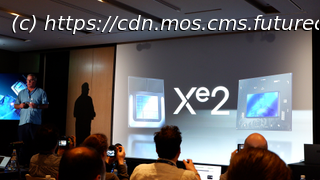The Xe2 GPU architecture will power everything from low-power mobile chips to desktop graphics cards.
Battlemage is coming. At least that’s what Intel says at an event dedicated to its new mobile processors, Lunar Lake. These new mobile chips give us a good idea of what to expect with Intel’s second graphics card generation—Lunar Lake and the upcoming Battlemage graphics cards share the same GPU architecture.
It’s called Xe2—with a little floating ‘e’ that our website won’t display properly. This new architecture will be found across the entire Intel product stack, which means no more Xe-HPG, Xe-LPG, or any of that nomenclature—it’s Xe2 all the way down.
You can see the new Lunar Lake processor on the left in the picture above. On the right, our first official image of the upcoming Battlemage GPU.
“What I’m confirming to you today is that the Xe2 architecture is going to be used in both,” Intel graphics spokesperson Tom Petersen says during a Lunar Lake graphics briefing.
An Xe2 GPU is divided into Render Slices, each Render Slice into four Xe-cores, and each Xe-core into eight Vector Engines.
Lunar Lake comes with eight Xe-cores. That’s not altogether very many for a gaming GPU, but for a better idea of what to expect in a discrete card you need only look to the the Arc A770. It comes with 32. So think of all the new additions to the Xe2 architecture listed here but multiplied a good few times over and you’ll have a rough estimate of Battlemage’s potential.
The new Xe2 architecture has been built to be scalable like that, Petersen says.
The Xe-cores in Xe2 have been improved for higher performance, better utilisation, and greater compatibility with games. That last point is particularly important, going off Intel’s previous form.
“Most often you’ll see games running right out of the box,” Petersen says.
I sure hope that’s the case. Behaviour that can best be described as clunky, or inconsistent, has been the thorn in the side of Intel’s first discrete cards, Alchemist.
Home
United States
USA — software It's on: our first look at Intel Battlemage comes from Lunar Lake's...






